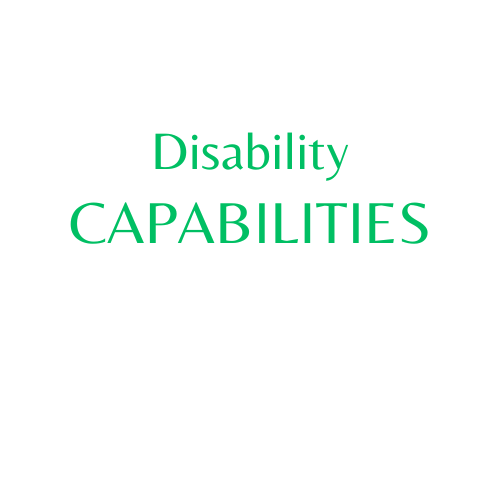Disability, Enhanced Capabilities & Discapability

Disability almost always means activating an innate ability that most people have not developed. This renders disabled persons as “uniquely able” persons.
In reality, most disabled people are simple persons set apart because of a visible or invisible disability. The modern society driven by economic goals tends to place labels on disabled persons and either victimize them or exclude them from society.
Many disabled persons can function at a very high level of efficiency if they are put in spaces where they can put their unique abilities to use.
Discapability
The concept of discapability is used to explain the notion of presenting disabled persons as persons with “a limited capability set compared to his/her objectives, ambitions, and system of values”[1]. Thus, discapability means setting a glass box and putting a disabled person in it to ensure that they feel less of themselves.
Naturally, a disabled person will think in terms of the objectives and ambitions created by the environment they live in.
On the other hand, when disabled persons are judged on the basis of their enhanced capabilities resulting from their ability to activate various competencies on their path, they can live productive and fulfilling lives.
Abnormalizing the Uncommon
Plato postulated that geniuses have some sort of creative insanity or “amabilis insania” which drives poets, inventors, and prophets[2]. In other words, when people live on the “normal” plane of society, they cannot see hidden things or thrive in faraway places.
To break out of limitations and restrictions and create novel solutions, one needs a heightened capability in a specific area that might compromise other capabilities that are seen as basic by society.
Thus, discapability is a process created by society at large in a quest to develop standards that ensure “normal” functionality. Thus, most disabilities are judged on the basis of what is abnormal in society.
There are certain pervasive observations about highly gifted children that show they are likely to experience:
1. More frequent behavioral problems
2. Greater emotional adjustment issues, and
3. A higher level of social isolation[3]
From this, we notice that giftedness could potentially be considered a “disability”. This creates a path where high-functioning persons are abnormalized and problematized by society.
Educators have come up with two divergent theories about gifted students:
1. The harmony hypothesis, and
2. The disharmony hypothesis [4]
The harmony hypothesis asserts that gifted students are superior in all domains, and therefore take positions that others might find to be insane. We have seen many abnormal positions and ideas grow to become accepted as superior.
The disharmony hypothesis posits that giftedness leads to maladaptive social behaviors and emotional problems.
Whichever theory is proven right, what is considered “normal” and “abnormal” is often determined by the majority. And this can lead to a process that ostracizes and excludes gifted persons leading to the discapability of otherwise capable and high-functioning persons
Compensatory Competency in Disabled People
Furthermore, every disability creates an opportunity to develop other capabilities to superhuman levels. Some of the trends are pervasive and can be proven empirically without doubt. It is up to society to streamline these competencies and place persons with compensatory capabilities in roles they excel the most in.
Vision-impaired persons hear better because they are able to localize sounds, filter them, and apply judgments that are extremely superior[5].
Persons with dyslexia might have challenges reading and identifying speech sounds or decoding ideas from combined words. However, they have greater strengths in strategic thinking, developing a panoramic view of things, showing genuine empathy, and superior narrative reasoning[6].
Autistic persons have divergent thought processes and often show perfectionist tendencies. They are likely to exhibit rigid thinking, restricted interests, and interpret speech and behaviors literally[7]. Studies have shown that autistic persons have superior writing skills and greater nonverbal intelligence[8]. They excel in roles that require attention to detail, creativity, hyperfocus, and special interest expertise[9].
People with attention-deficiency (ADHD) are extremely good at multitasking at a much faster rate than most other people. These are persons who experience restlessness, boredom, changes in focus, and varying interest levels. However, when they find themselves in fast-paced busy, and physically demanding work environments that they find intrinsically interesting, they perform at extremely high levels[10].
Similarly, a person who uses a wheelchair gets to view the world differently. This ranges from a mix of factors and circumstances that enhance their ways of understanding the world. This makes them great innovators and critical analysts.
In today’s advanced technological system, it is possible to place persons in areas where they can excel the most and exceed their perceived or actual disabilities. Society must work to empower individuals to live above discapability and enhance compensatory competencies to overshadow disabilities.
Take Away Points
Putting it all together,
· Disability is often defined in terms of what the society thinks about individuals based on their physical features, social engagement capabilities, behavioral tendencies, or mental health features.
· Discapability involves objectives set by people under dominant social patterns and circumstantial factors that can create a glass box that renders certain people less capable, incapable, or disabled.
· People with enhanced capabilities are often abnormalized and wrongfully labeled as disabled
· All disabled persons have some compensatory capabilities.
· Society can streamline, leverage, optimize, and benefit from the many compensatory capabilities that are inherent in persons classified as disabled.
A strength-based approach to empowering capabilities in disabled persons can create win-win results for all.
[1] Nicolo Bellanca, Mario Biggeri & Francesca Marchetta. "An extension of the capability approach: Towards a theory of dis-capability" Alter 5 (3) 2011 pp158-176
[2] Kurt Heller. Excellence: Essays in Honour of Kurt A. Heller. (Zurich: Lit Verlag, 2011) p77
[3] Kurt Heller. Excellence: Essays in Honour of Kurt A. Heller. (Zurich: Lit Verlag, 2011) p77
[4] Tanja Gabriele Baudson & Franzis, Perkel. "Teachers' implicit personality theories about the gifted: An experimental approach." School Psychology Quarterly 28 (1) 2013 pp37-46
[5] Loss of Sight and Enhanced Hearing: A Neural Picture. PLoS Biol. 2005 Feb;3(2):e48. doi: 10.1371/journal.pbio.0030048. Epub 2005 Jan 25. PMCID: PMC544930.
[6] Brock L. Eide & Fernette F. Eide. The Dyslexic Advantage. (New York: Penguin Random House LLC, 2023) p45, p152
[7] Barb Cohen. "Autism and Creativity Do autistic people lack creativity, or are the measures of creativity lacking?" Psychology Today. Published: December 18, 2016. Available at: https://www.psychologytoday.com/intl/blog/mom-am-i-disabled/201612/autism-and-creativity
[8] Kirsten Gillespie-Lynch, Emily Hotez, Kavi Luca. "Comparing the writing skills of autistic and nonautistic university students: A collaboration with autistic university students" Autism 24 (7) 2020 pp1898-1912
[9] Liron Rosenkrantz, Anila D'Mello & John Gabrieli. "Enhanced rationality in autism spectrum disorder" Cell Reports Review 25 (8) 2021 pp685-696 Available at: https://www.cell.com/trends/cognitive-sciences/fulltext/S1364-6613(21)00125-X#secst0065
[10] Arielle Lasky, Thomas Weisner, Peter Jensen, Stephen Hinshaw, Lily Hetchman, Eugene Arnold, Desiree Murray & James Swanson. "ADHD in context: Young adults’ reports of the impact of occupational environment on the manifestation of ADHD" Social Science & Medicine 161 2016 pp160-168





